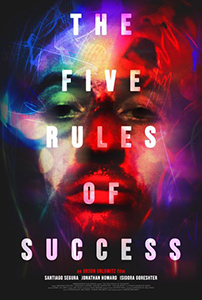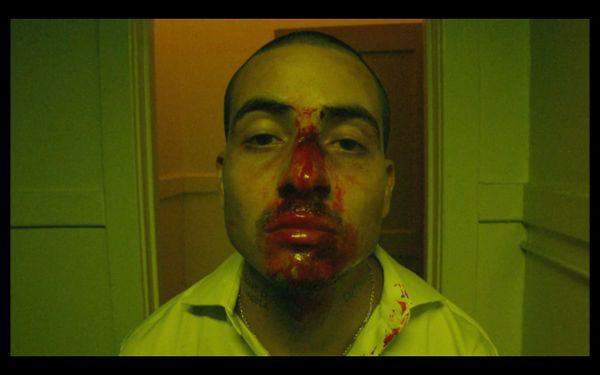An Ex-Con Falls Down the Rabbit Hole in a Desperate bid for the American Dream.
DIRECTED BY ORSON OBLOWITZ / 2020

The protagonist of The Five Rules of Success is a young man know to us only as ‘X.’ He has spent all of his young adult life in prison, and as the film starts, he is getting released on parole. His parole officer, Emma (Isidora Goreshter), warns him that he is just one small misstep away from having his parole revoked and getting sent back to prison. X isn’t concerned about that. He’s outlined a plan for himself while he was behind bars. He’s ready to focus on his goals and work hard to bring them into being. The problem is the rest of the World isn’t exactly willing to let him do that.
As portrayed by Santiago Segura, X is quiet and serious. His life goals are kept as a photo montage glued to a small piece of cardboard. No doubt X is a fan of Michael Mann’s Thief. He gets a small place to live, and a job as a delivery driver for a restaurant run by a man named Avakian (Jon Sklaroff). Avakian takes a shine to this earnest, hard-working young man. Avakian’s own son, Danny (Jonathan Howard), is a disappointment to him. Danny isn’t the sort of guy someone who’s out on parole should be around.
As X begins to realize that achieving one’s dream can be difficult – even more so for an ex-convict – he begins to be tempted by the promise of easy money offered to him by a local gangster. The gangster always has work for guys like Danny, and for guys like X who have a dream, and will do whatever it takes to achieve it.

The Five Rules of Success is shot in a way that almost makes Se7en look like Better Homes and Gardens. Expressionistic lighting, ultra-wide camera lenses, discombobulating jump cuts, changing aspect ratios, and long tracking shots punctuate the film giving it a gritty, neo-noir style. Writer/Director Orson Obolwitz also served as his own cinematographer and editor, and he pulled out all the stops to make sure Five Rules makes an impression.
The movie is broken into five chapters, each one titled with the eponymous Rules for Success. These chapter headings just become more and more bitterly ironic as the story progresses. X wants to succeed (he dreams of owning his own restaurant) and has every intention of working within the bounds to reach that success, but he is denied help at every opportunity. Even those who are supposedly there to provide some level of help, like his parole officer, treat him as just another “prisoner on vacation.” She assumes it’s just a matter of time before he winds back up in the slammer. As her own interactions with him begin to veer into the abusive, her perception of him starts to look like a self-fulfilling prophecy.
X’s journey is punctuated by quick, almost aggressive, flashes of the memories of his childhood and the crime that led him to getting arrested in the first place as a teenager. As the full scope of the event that landed him in jail and set him on his path as a criminal becomes clear, it’s evident that X never really had any chance at all to succeed, no matter how many rules he tries to live by.


